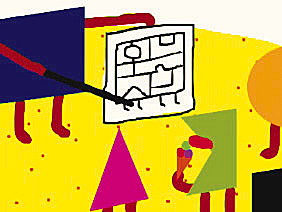|
Jindra (b. 1978) studied at the Applied Arts College in Prague, in the Illustration and Graphics Studio of professor Jiří Šalamoun, from 1997 – 2000.
Michal Jindra is impossible to categorize due to the number of genres he works in. His work could be described as either outsider art or the product of a psychologically disturbed individual, perhaps an extraterrestrial. He makes it difficult to estimate the extent to which this is due to his confused imagination, his thought processes or the untamed clamor of his subconscious. Probably all of the above blend together in the creation of his psychedelic and intelligent, original works. His comics and cartoons are typical for their childlike style, dominated by deliberate color schemes and composition tricks. Jindra uses an innocent black humor, which gives his infantile works almost terrifying dimension. The stories seem ambiguous, but they inherently radiate the hope that good will triumph over evil. Sci-fi elements in Jindra’s work are the result of his extra-social cognition rather than any tendentious factors. It is interesting to follow Jindra’s development, which can be best described as apocalyptic. It’s a shame that he was thrown out of art school.
Рекомендуемые статьи

|
|
Why political intellectuals, do you incline towards the proletariat? In commiseration for what? I realize that a proletarian would hate you, you have no hatred because you are bourgeois, privileged, smooth-skinned types, but also because you dare not say that the only important thing there is to say, that one can enjoy swallowing the shit of capital, its materials, its metal bars, its polystyrene…
|

|
|
There’s 130 kilos of fat, muscles, brain & raw power on the Serbian contemporary art scene, all molded together into a 175-cm tall, 44-year-old body. It’s owner is known by a countless number of different names, including Bamboo, Mexican, Groom, Big Pain in the Ass, but most of all he’s known as MICROBE!… Hero of the losers, fighter for the rights of the dispossessed, folk artist, entertainer…
|

|
|
"In Cameroon, rumours abound of zombie-labourers toiling on invisible plantations in an obscure night-time economy."
|

|
|
There is nothing that has not already been done in culture, squeezed or pulled inside out, blown to dust. Classical culture today is made by scum. Those working in the fine arts who make paintings are called artists. Otherwise in the backwaters and marshlands the rest of the artists are lost in search of new and ever surprising methods. They must be earthbound, casual, political, managerial,…
|
|











Комментарии
Статья не была прокомментированаДобавить новый комментарий